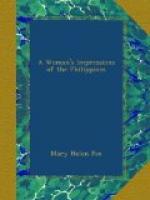The first time I went to church in Capiz and looked down from the choir loft on the congregation, I could think of nothing but a kaleidoscope, and the colored motes that fall continually into new forms and shapes. When the results of the war had made themselves felt, and the cholera had ravaged the province, this variety of color was lost, and the congregation appeared a veritable house of mourning. This was not, however, due to the appalling mortality, but to the Filipinos’ punctilious habit of putting on mourning. When death visits a family, rich or poor, even the most distant relatives go into mourning, and they cling to it for the required time.
If the reader will take into consideration all that I have said about the part played by the Church in Filipino life, and at the same time consider their insular isolation, their lack of familiarity either through literature or travel with other civilizations, he will readily perceive that religion means a totally different thing in the Philippines from what it does in America, even in Roman Catholic America.
To the complacent Protestant evangelist who smacks his lips in anticipation of the future conquest of these Islands, I would say frankly that there is no room for Protestantism in the Philippines. The introspective quality which is inherent in true Protestantism is not in the Filipino temperament. Neither are the vein of simplicity and the dogmatic spirit which made the strength of the Reformation. Protestantism will, of course, make some progress so long as the fire is artificially fanned. There will always be found a few who cling ardently to it. But most Americans with whom I have talked (and their name is legion) have agreed with me in thinking that it will never be strong here.
The attitude of the Filipino Catholic is at once tolerant and positive. It is positive because without any research into theological disputes the ordinary Filipino is emotionally loyal to his Church and satisfied with the very positive promises which that Church gives him. It ministers not only to his spiritual but to his material needs on earth, and it promises him in no circumlocutory terms salvation or damnation. It either gives him or denies him absolution. He believes in it with the implicit faith of one who has never investigated. On the other hand, he is tolerant with the tolerance of one who has in his blood none of the acrimony begotten by an ancestry alternately conquerors and victims through their faith. The Filipino Catholic is far more tolerant than the Irish or German Catholic. But the Philippines have known no battle of the Boyne, no Thirty Years’ War. When the abuses of the friars here led to revolt and insurrection, the ultimate outcome of the struggle would have been probably a religious secession from Rome, as well as political severance from Spain, had not the accident of the Spanish-American War precipitated us upon the scene, and settled the matter by the immediate expulsion of the Spanish Government. The only real point of infection left to create a sore in the new body Filipino—the friar lands—was fortunately so treated by Secretary Taft that it ceased to menace the State or threaten to mingle religion with government.




